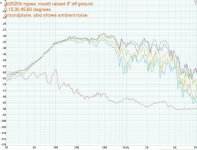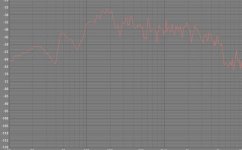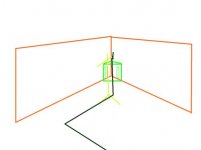bentoronto said:But the music room performance is all that counts in DIY.
If the music room performance is all that counts why do you need a measurement 'without room' ?
Nor am I optimistic about "... well, you just subtract out the room response." Is there a way of doing so?
Yes - you physically remove the room by placing the speaker out in open space and measure there....
I appreciate both you's posts and I hope all this is being taken in the right scientific-inquiring way.
First, if I may quote my very first post in this thread:
"On good theoretical and practical grounds, I like pink noise or frequency sweeps using 1/3 octave bands - I have some signals off an old CBS-labs test record. The ear and the SPL meter show some agreement and the measurement experience makes seems coherent."
Yes, you have a fightin' chance of meaningful measurements in your living room with noise. Moreover, the 1/3 octave stuff I grew up with is crude and not great help in fine-tuning. Now I see you can do really fine work at 1/24 octave bands that produces a reliable (consistent, repeatable, fine-enough) trace. I am in your debt for that knowledge.
What I'd like to see now, is the relation of the indoors and out of doors "racquetball court" curves on the same chart in order to assess the value of collecting out of doors data. Does in-room variation swamp out of doors curves?
To operationalize a criterion, could you usefully set a bass equalizer from the racquetball curve?
First, if I may quote my very first post in this thread:
"On good theoretical and practical grounds, I like pink noise or frequency sweeps using 1/3 octave bands - I have some signals off an old CBS-labs test record. The ear and the SPL meter show some agreement and the measurement experience makes seems coherent."
Yes, you have a fightin' chance of meaningful measurements in your living room with noise. Moreover, the 1/3 octave stuff I grew up with is crude and not great help in fine-tuning. Now I see you can do really fine work at 1/24 octave bands that produces a reliable (consistent, repeatable, fine-enough) trace. I am in your debt for that knowledge.
What I'd like to see now, is the relation of the indoors and out of doors "racquetball court" curves on the same chart in order to assess the value of collecting out of doors data. Does in-room variation swamp out of doors curves?
To operationalize a criterion, could you usefully set a bass equalizer from the racquetball curve?
So basically all you want to do is EQ your klipsch to a 'flat before room modes' condition ?, but cannot as it needs the corners to function as a 'proper' horn, meaning the outdoor measurements are useless as the speaker will not work without the floor / walls to complete its horn flare ?
I understand your position now and why you was so 'put out' by Tom D's suggestions.......(and why you spoke about raising the walls with the speaker)
In your case I think you need to find 2 very high buildings that join at right angles. Get an in car amp and a laptop adapter / inverter so you can power the laptop and preamp / mic combo. This gives you a mobile testing station so you can drive out, stick the horn in a good test corner, and measure it. A standard mic stand should hold the mic in the right position (equidistant from all surfaces)
Hopefully that will get you the info you're searching for, although maybe the cost of the equipment will be the deciding factor.
Rob.
I understand your position now and why you was so 'put out' by Tom D's suggestions.......(and why you spoke about raising the walls with the speaker)
In your case I think you need to find 2 very high buildings that join at right angles. Get an in car amp and a laptop adapter / inverter so you can power the laptop and preamp / mic combo. This gives you a mobile testing station so you can drive out, stick the horn in a good test corner, and measure it. A standard mic stand should hold the mic in the right position (equidistant from all surfaces)
Hopefully that will get you the info you're searching for, although maybe the cost of the equipment will be the deciding factor.
Rob.
RobWells said:So basically all you want to do is EQ your klipsch to a 'flat before room modes' condition ?, but cannot as it needs the corners to function as a 'proper' horn, meaning the outdoor measurements are useless as the speaker will not work without the floor / walls to complete its horn flare ?
I understand your position now and why you was so 'put out' by Tom D's suggestions.......(and why you spoke about raising the walls with the speaker)
In your case I think you need to find 2 very high buildings that join at right angles. Get an in car amp and a laptop adapter / inverter so you can power the laptop and preamp / mic combo. This gives you a mobile testing station so you can drive out, stick the horn in a good test corner, and measure it. A standard mic stand should hold the mic in the right position (equidistant from all surfaces)
Hopefully that will get you the info you're searching for, although maybe the cost of the equipment will be the deciding factor.
Rob.
Wait. Not my thread. Sorry to hijack. But I am very interested in the question.
No, my purpose isn't to use out of doors measures. On the contrary, I am skeptical that they can be useful with a woofer and esp. with a corner horn (and hope to be proven wrong).
As a kind of conceptual test case, I am asking if equalizing based on an out of doors curve would be adequate. If yes, then I guess out of doors is useful. If not, then, not. To start with, what do the indoors and out of doors curves look like when on the same chart? I am just trying to formulate a test case to represent the words "Gee, the two curves are kinda' alike."
Earlier, and esp. in connection with Tom's posts, the question of economic feasibility (and structural feasibility) were raised. These are of the greatest practical importance and I'd like to learn more about the price for a 1/24 octave filter, time window, and whatever else is needed too.
But first, the conceptual test case.
In the PA world... the best thing you can do is take your system to a big open field, and eq it to the sound you are looking for. Once you do that, then you find out that your eq sounds pretty good in all rooms, and only needs small adjustments.
BEFORE that outdoors eq is accomplished, you find that you are constantly fighting the eq from place to place.
I believe the same applies to your situation. Take it out to a tricorner, measure, and eq it to what you really want, and then... and only then, bring it back indoors.
My analogy is trying to find the best tomato in a BLT. When the tomato is in the sandwich, it's much more difficult to identify a great tomato from a good one, because of the competition of all of the other tastes. However once by itself, it's much easier. Once you take that great tomato and put it back in the BLT, the BLT is just that much better.
The same is also true in the speaker design phase. (Tom's comments) You can't tell the strong and weak points of a design, indoors... you need to take it outdoors to measure.
BTW -- I'm acutely aware of the issues that happen when dealing with bass horns and indoor measurements. I based a stadium system on published SPL charts... only to find out that the published charts were measured indoors. Obviously the design did NOT perform as advertised....
hope that helps.
BEFORE that outdoors eq is accomplished, you find that you are constantly fighting the eq from place to place.
I believe the same applies to your situation. Take it out to a tricorner, measure, and eq it to what you really want, and then... and only then, bring it back indoors.
My analogy is trying to find the best tomato in a BLT. When the tomato is in the sandwich, it's much more difficult to identify a great tomato from a good one, because of the competition of all of the other tastes. However once by itself, it's much easier. Once you take that great tomato and put it back in the BLT, the BLT is just that much better.
The same is also true in the speaker design phase. (Tom's comments) You can't tell the strong and weak points of a design, indoors... you need to take it outdoors to measure.
BTW -- I'm acutely aware of the issues that happen when dealing with bass horns and indoor measurements. I based a stadium system on published SPL charts... only to find out that the published charts were measured indoors. Obviously the design did NOT perform as advertised....
hope that helps.
There are bits a pieces of good info in every post.
To the point of sharpening the pencil a bit more.
I think we all know how to measure the response. We all agree that measuring a horn at distance outside gives an accurate result.
Most of us have this evil thing called winter. I have been working on a couple of horns all winter and I never seem to get them to measure the same inside as outside.
What has been posted is pointing to the direction of measure outside and then figure out what is not going right inside.
Unfortunately that is what we all do with horns. After it is actually nice here in Ottawa I'm going to try some experiments to see if I can really relate a close mic response to a 10 meter ground plane response.
If it works to some degree I'll post it and see what you guys come up with. Because if there is some way to accurately predict an in room response by a little jugling of the db's down a bit then I can produce better results in the winter to!
Mark
"On this half of the planet we are going into spring." Sorry Rob I thought you lived down under. I should look more closely sometimes!
To the point of sharpening the pencil a bit more.
I think we all know how to measure the response. We all agree that measuring a horn at distance outside gives an accurate result.
Most of us have this evil thing called winter. I have been working on a couple of horns all winter and I never seem to get them to measure the same inside as outside.
What has been posted is pointing to the direction of measure outside and then figure out what is not going right inside.
Unfortunately that is what we all do with horns. After it is actually nice here in Ottawa I'm going to try some experiments to see if I can really relate a close mic response to a 10 meter ground plane response.
If it works to some degree I'll post it and see what you guys come up with. Because if there is some way to accurately predict an in room response by a little jugling of the db's down a bit then I can produce better results in the winter to!
Mark
"On this half of the planet we are going into spring." Sorry Rob I thought you lived down under. I should look more closely sometimes!
Knowing this is years ago, I post an ideer anyway. Maybe there is life out there?
There was this one ideer of finding a correction-curve for inroom-messurments.
How about building a sealed sub and do outside measuring plus Eq' ing for flat response (ore som other useful targetcurve/realistic curve). And then pull the sealed sub inside and measure "roomcurves" for different positions in the room, taking into account that horns are big and that the hornmouth is at different places in the room.
I guess it is about developing a standard.
Steffen DK
There was this one ideer of finding a correction-curve for inroom-messurments.
How about building a sealed sub and do outside measuring plus Eq' ing for flat response (ore som other useful targetcurve/realistic curve). And then pull the sealed sub inside and measure "roomcurves" for different positions in the room, taking into account that horns are big and that the hornmouth is at different places in the room.
I guess it is about developing a standard.
Steffen DK
How about building a sealed sub and do outside measuring plus Eq' ing for flat response (ore som other useful targetcurve/realistic curve). And then pull the sealed sub inside and measure "roomcurves" for different positions in the room, taking into account that horns are big and that the hornmouth is at different places in the room.
That's essentially this (excellent) article.
Data-Bass
I guess it is about developing a standard.
The problem is that there cannot be a standard. The article says, "Put simply, gain is not assured at all at any specific frequency."
Using EQ is not exactly a 'correction'. A room causes sound to be distributed in space so that dips in one location can correspond to peaks in other places. A fix should consider this.
When it comes to horns, they can have their own distribution (eg where diffraction happens at places other than the throat). At bass frequencies this can change the room interaction and at high frequencies there are other problems it can create.
When it comes to horns, they can have their own distribution (eg where diffraction happens at places other than the throat). At bass frequencies this can change the room interaction and at high frequencies there are other problems it can create.
Last edited:
The problem with horns is that they are natural to clearcut analysis. So that leads to folks staying up late at night and drawing lobes and comb filters and other stuff that people and probably animals can't perceive (and that's lucky because our audio world would be pretty confused it we didn't process out that stuff).
Having a folded horn in a corner of a room may instigate diversity and heterogeneity. That's the logic behind the current craze for multiple subs around the room.
Now, 7 yrs after this thread started, I can still say I have no satisfying road to easy one-pass speaker measurement in a room. But a few measurements averaged using REW does provide a pretty helpful picture. If you are a repeat measurer like me, I use a camera tripod and put a mic where my head would be on my one listening chair and repeat the location with pretty good accuracy. Each location is different but if you use the same location repeatedly, you have a trail.
Ben
Having a folded horn in a corner of a room may instigate diversity and heterogeneity. That's the logic behind the current craze for multiple subs around the room.
Now, 7 yrs after this thread started, I can still say I have no satisfying road to easy one-pass speaker measurement in a room. But a few measurements averaged using REW does provide a pretty helpful picture. If you are a repeat measurer like me, I use a camera tripod and put a mic where my head would be on my one listening chair and repeat the location with pretty good accuracy. Each location is different but if you use the same location repeatedly, you have a trail.
Ben
Last edited:
Hmmmm. Thanks for all the answers.
I don´t know if I manneged to communicate my original ideer, and if it indeed would be practical? I have no experience doing measurments yet, so I won´t try to keep arguing, knowing it is a complex matter. I think I need to collect some hands on experience my self first. And I´m confident, that others who have experience and skills, have tried to solve the problem of evaluating sub-designs inroom.
I guess it was kind of the little Einstein in me, playing with a mind-experiment. ;-)
Thanks again and marry christmass
Steffen
I don´t know if I manneged to communicate my original ideer, and if it indeed would be practical? I have no experience doing measurments yet, so I won´t try to keep arguing, knowing it is a complex matter. I think I need to collect some hands on experience my self first. And I´m confident, that others who have experience and skills, have tried to solve the problem of evaluating sub-designs inroom.
I guess it was kind of the little Einstein in me, playing with a mind-experiment. ;-)
Thanks again and marry christmass
Steffen
- Status
- This old topic is closed. If you want to reopen this topic, contact a moderator using the "Report Post" button.
- Home
- Loudspeakers
- Subwoofers
- Correct Way to measure a horn loudspeaker


